人教PEP版六年级上册语法讲解与强化训练 Unit 2 Ways to go to school(含答案)
文档属性
| 名称 | 人教PEP版六年级上册语法讲解与强化训练 Unit 2 Ways to go to school(含答案) | 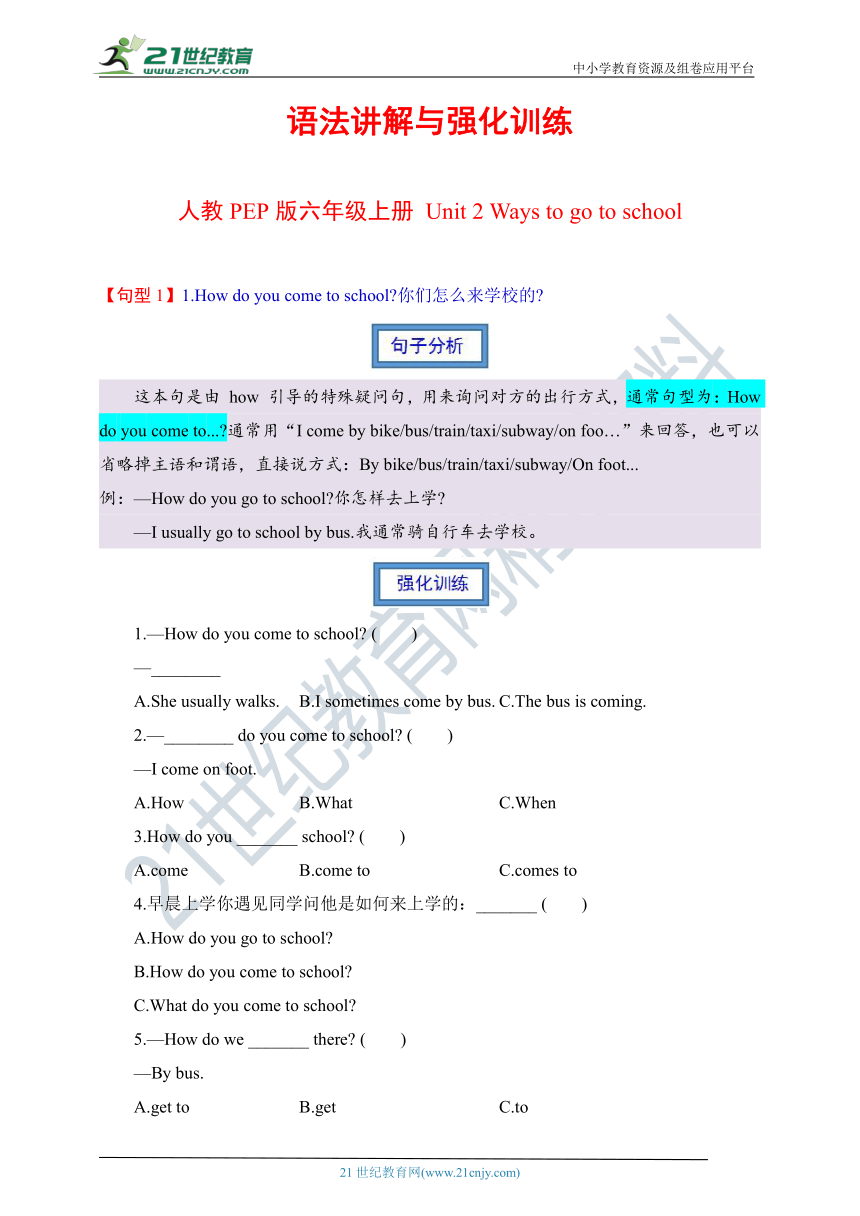 | |
| 格式 | doc | ||
| 文件大小 | 1.4MB | ||
| 资源类型 | 试卷 | ||
| 版本资源 | 人教版(PEP) | ||
| 科目 | 英语 | ||
| 更新时间 | 2022-09-20 09:34:06 | ||
图片预览

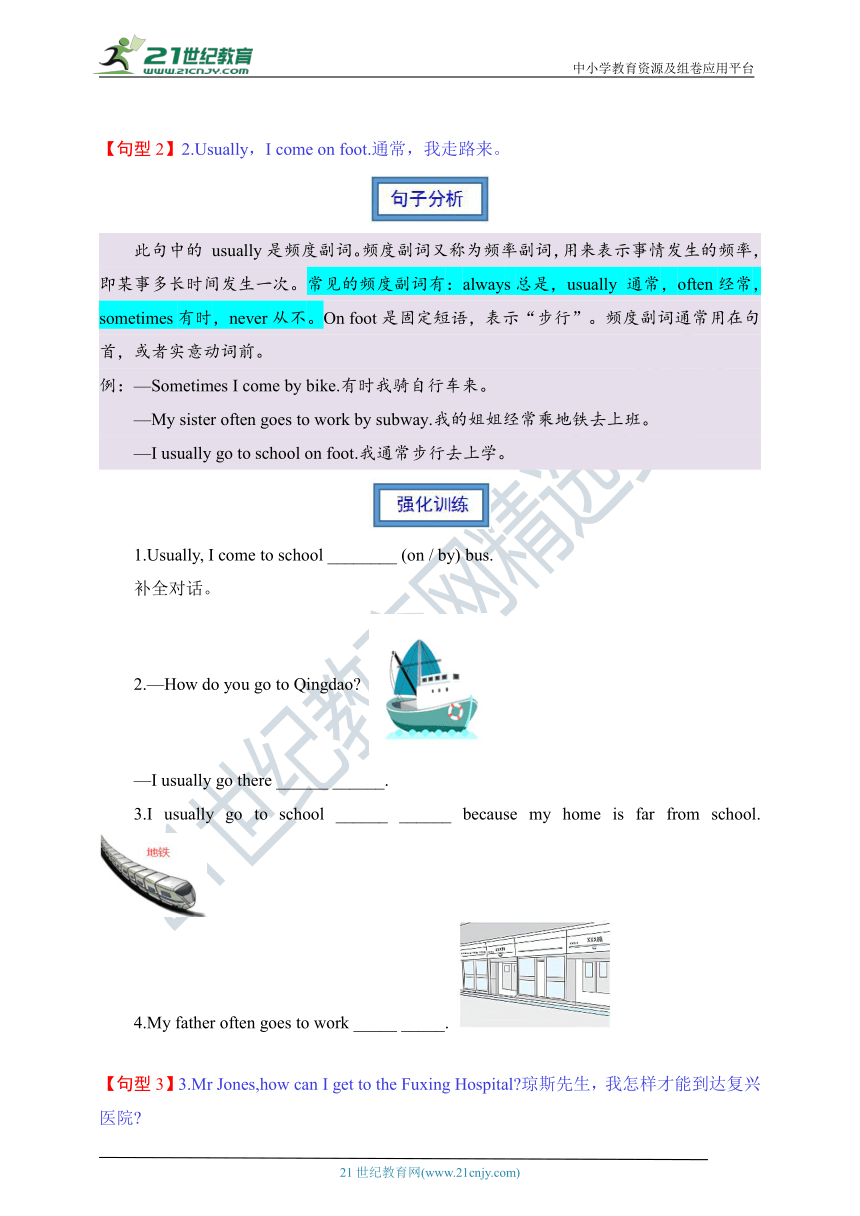
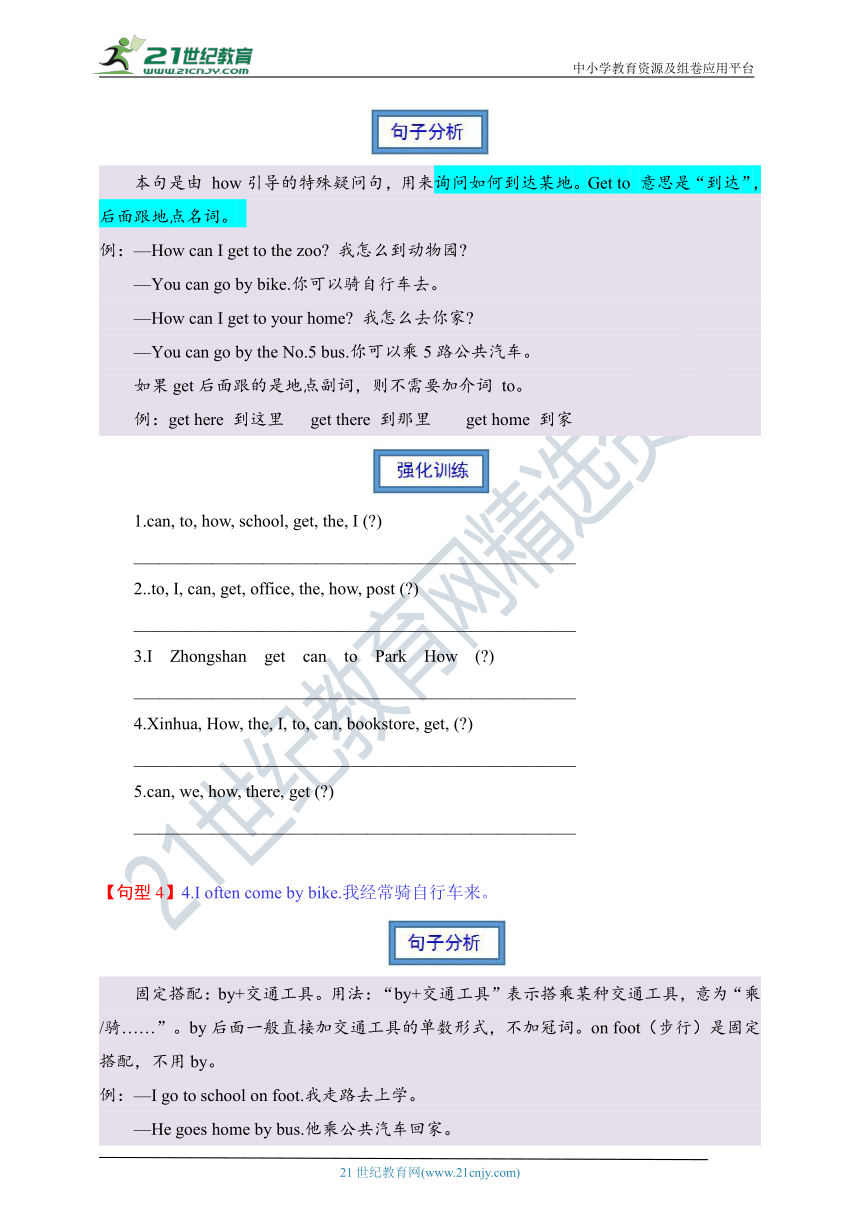
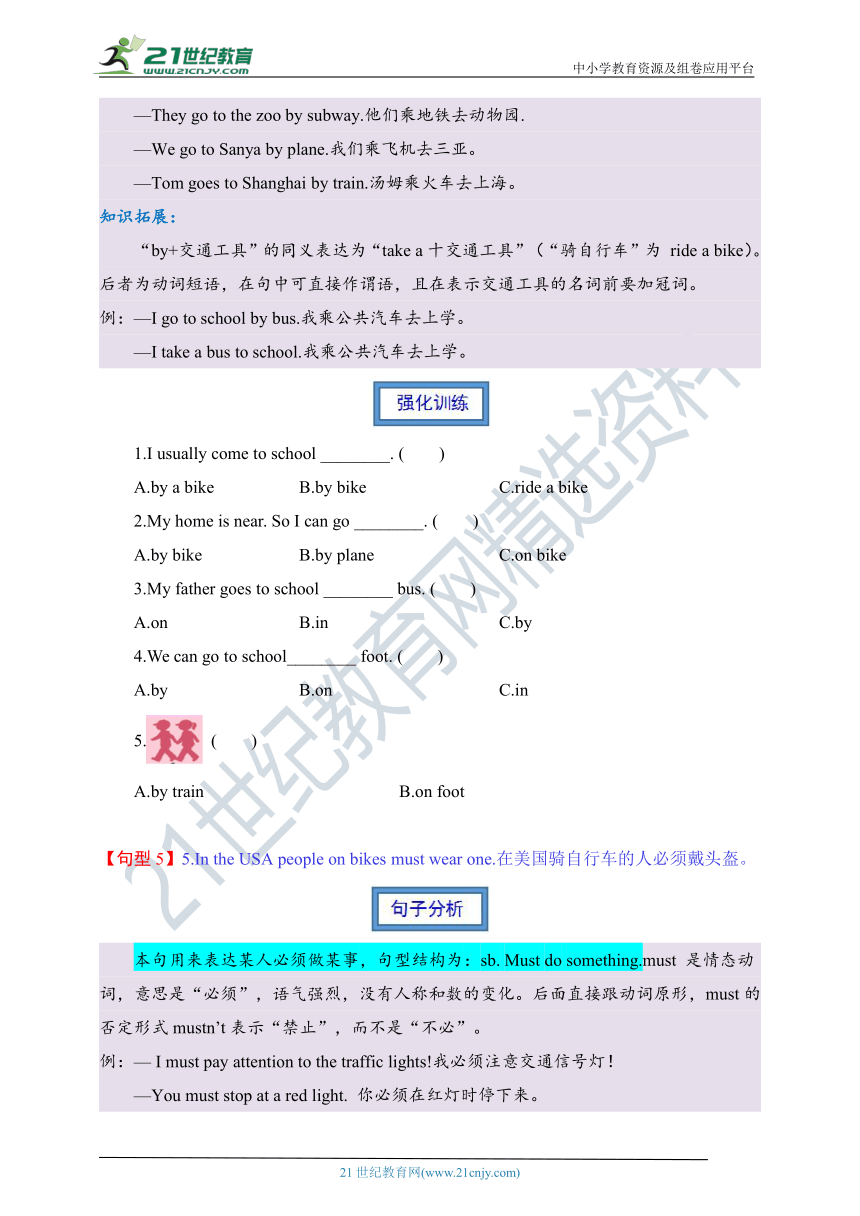
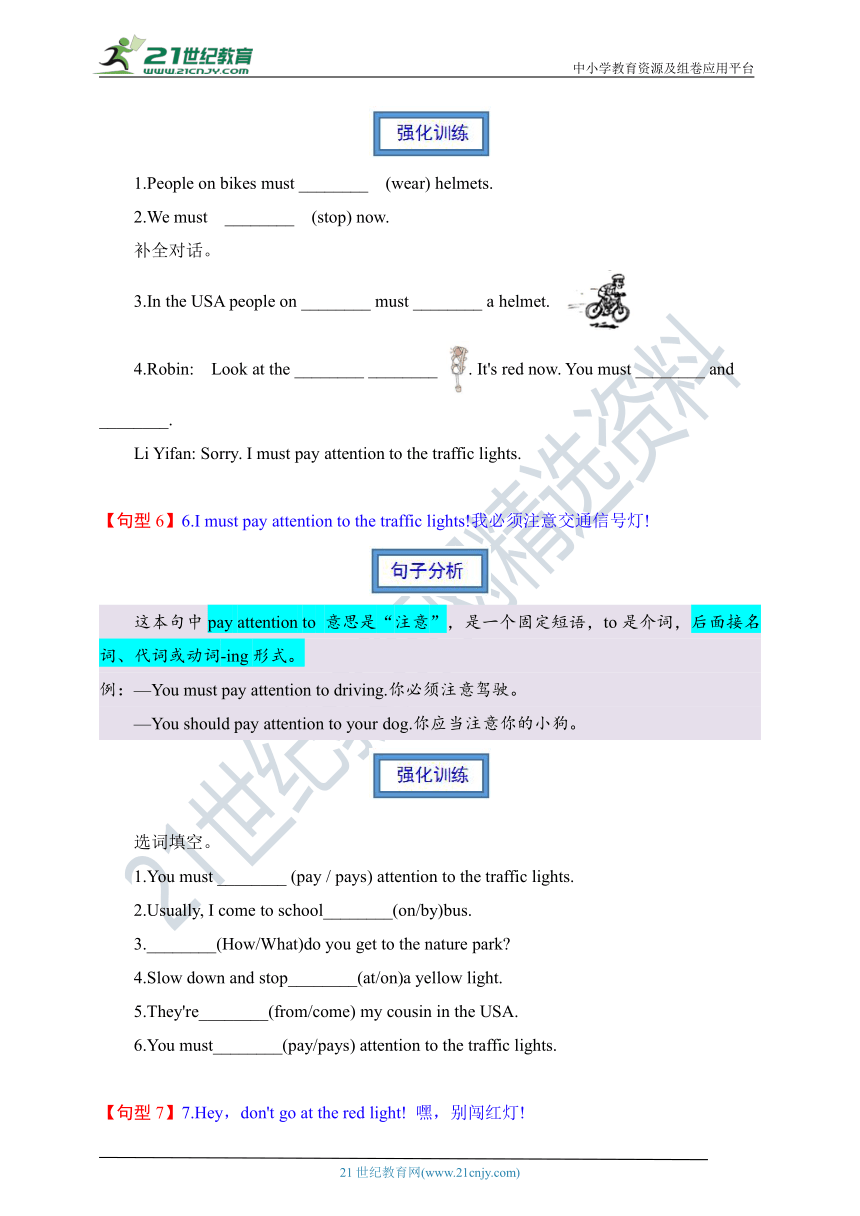
文档简介
中小学教育资源及组卷应用平台
语法讲解与强化训练
人教PEP版六年级上册 Unit 2 Ways to go to school
【句型1】1.How do you come to school 你们怎么来学校的
这本句是由 how 引导的特殊疑问句,用来询问对方的出行方式,通常句型为:How do you come to... 通常用“I come by bike/bus/train/taxi/subway/on foo…”来回答,也可以省略掉主语和谓语,直接说方式:By bike/bus/train/taxi/subway/On foot...
例:—How do you go to school 你怎样去上学
—I usually go to school by bus.我通常骑自行车去学校。
1.—How do you come to school ( )
—________
A.She usually walks. B.I sometimes come by bus. C.The bus is coming.
2.—________ do you come to school ( )
—I come on foot.
A.How B.What C.When
3.How do you _______ school ( )
A.come B.come to C.comes to
4.早晨上学你遇见同学问他是如何来上学的:_______ ( )
A.How do you go to school
B.How do you come to school
C.What do you come to school
5.—How do we _______ there ( )
—By bus.
A.get to B.get C.to
【句型2】2.Usually,I come on foot.通常,我走路来。
此句中的 usually是频度副词。频度副词又称为频率副词,用来表示事情发生的频率,即某事多长时间发生一次。常见的频度副词有:always总是,usually 通常,often经常,sometimes有时,never从不。On foot是固定短语,表示“步行”。频度副词通常用在句首,或者实意动词前。
例:—Sometimes I come by bike.有时我骑自行车来。
—My sister often goes to work by subway.我的姐姐经常乘地铁去上班。
—I usually go to school on foot.我通常步行去上学。
1.Usually, I come to school ________ (on / by) bus.
补全对话。
2.—How do you go to Qingdao
—I usually go there ______ ______.
3.I usually go to school ______ ______ because my home is far from school.
4.My father often goes to work _____ _____.
【句型3】3.Mr Jones,how can I get to the Fuxing Hospital 琼斯先生,我怎样才能到达复兴医院
本句是由 how引导的特殊疑问句,用来询问如何到达某地。Get to 意思是“到达”,后面跟地点名词。
例:—How can I get to the zoo 我怎么到动物园
—You can go by bike.你可以骑自行车去。
—How can I get to your home 我怎么去你家
—You can go by the No.5 bus.你可以乘5路公共汽车。
如果get后面跟的是地点副词,则不需要加介词 to。
例:get here 到这里 get there 到那里 get home 到家
1.can, to, how, school, get, the, I ( )
___________________________________________________
2..to, I, can, get, office, the, how, post ( )
___________________________________________________
3.I Zhongshan get can to Park How ( )
___________________________________________________
4.Xinhua, How, the, I, to, can, bookstore, get, ( )
___________________________________________________
5.can, we, how, there, get ( )
___________________________________________________
【句型4】4.I often come by bike.我经常骑自行车来。
固定搭配:by+交通工具。用法:“by+交通工具”表示搭乘某种交通工具,意为“乘/骑……”。by后面一般直接加交通工具的单数形式,不加冠词。on foot(步行)是固定搭配,不用by。
例:—I go to school on foot.我走路去上学。
—He goes home by bus.他乘公共汽车回家。
—They go to the zoo by subway.他们乘地铁去动物园.
—We go to Sanya by plane.我们乘飞机去三亚。
—Tom goes to Shanghai by train.汤姆乘火车去上海。
知识拓展:
“by+交通工具”的同义表达为“take a十交通工具”(“骑自行车”为 ride a bike)。后者为动词短语,在句中可直接作谓语,且在表示交通工具的名词前要加冠词。
例:—I go to school by bus.我乘公共汽车去上学。
—I take a bus to school.我乘公共汽车去上学。
1.I usually come to school ________. ( )
A.by a bike B.by bike C.ride a bike
2.My home is near. So I can go ________. ( )
A.by bike B.by plane C.on bike
3.My father goes to school ________ bus. ( )
A.on B.in C.by
4.We can go to school________ foot. ( )
A.by B.on C.in
5. ( )
A.by train B.on foot
【句型5】5.In the USA people on bikes must wear one.在美国骑自行车的人必须戴头盔。
本句用来表达某人必须做某事,句型结构为:sb. Must do something.must 是情态动词,意思是“必须”,语气强烈,没有人称和数的变化。后面直接跟动词原形,must的否定形式mustn’t表示“禁止”,而不是“不必”。
例:— I must pay attention to the traffic lights!我必须注意交通信号灯!
—You must stop at a red light. 你必须在红灯时停下来。
1.People on bikes must ________ (wear) helmets.
2.We must ________ (stop) now.
补全对话。
3.In the USA people on ________ must ________ a helmet.
4.Robin: Look at the ________ ________ . It's red now. You must ________ and ________.
Li Yifan: Sorry. I must pay attention to the traffic lights.
【句型6】6.I must pay attention to the traffic lights!我必须注意交通信号灯!
这本句中pay attention to 意思是“注意”,是一个固定短语,to是介词,后面接名词、代词或动词-ing形式。
例:—You must pay attention to driving.你必须注意驾驶。
—You should pay attention to your dog.你应当注意你的小狗。
选词填空。
1.You must ________ (pay / pays) attention to the traffic lights.
2.Usually, I come to school________(on/by)bus.
3.________(How/What)do you get to the nature park
4.Slow down and stop________(at/on)a yellow light.
5.They're________(from/come) my cousin in the USA.
6.You must________(pay/pays) attention to the traffic lights.
【句型7】7.Hey,don't go at the red light! 嘿,别闯红灯!
这句话的句型结构:Don't+动词原形+其他.此句是祈使句的否定形式,意为“不要做某事”,用于命令、请求、劝告或警告对方不要做某事,语气严厉。
例:—Don't take photos!禁止拍照!
—Don’t touch the door.请勿触摸门。
1.Don't ________ the door. ( )
A.see B.open C.touch
2.Don't let the dog ________ too fast. ( )
A.runs B.to run C.run
3.Don't ______ late for school!
A.are B.be C.to be
4.Don't run very __________ on the street! ( )
A.slow B.fast C.slow down
5.Don't let the kid ______ at a red light. ( )
A.go B.goes C.on
参考答案
强化训练1
1.B【解析】问句句意:你怎么来学校的?A她通常步行。B我有时坐公共汽车来。C公共汽车来了。选项B符合题意,故选B。
2.A【解析】句意:—你_____去上学?—我步行去。A怎么样,B什么,C什么时候,根据答语可知问句用how提问,故选A。
3.B【解析】句意:你怎么来学校?come to school来学校,固定搭配;前面有助动词do,后面的实义动词用原形。故选B。
4.B【解析】句意:A你怎么去上学的?B你怎么来上学的?C你来学校做什么?想问对方如何来上学的,故选B。
5.B【解析】句意:—我们怎么到那?—乘公共汽车。get there到那,固定搭配,there是地点副词,前面不加介词to,故选B。
强化训练2
1.by【解析】句子含义为“我通常坐公交车来学校”,by bus意为“乘公交车”,故答案为。
2.by ship【解析】略。
3.by subway【解析】略。
4.by subway【解析】句意:我的父亲经常_____去上班。根据句意和图片中的地铁,可知横线处应填交通方式,乘坐地铁,用by subway表示。故答案为by subway。
强化训练3
1.How can I get to the school 【解析】can能,get to the school去学校,how怎么样,I我,根据所给问号,可知句子是疑问句,根据词义连成句子:我怎么去学校?故答案为How can I get to the school
2.How can I get to the post office 【解析】get to到达,I我,can能,post office邮局,the定冠词,how怎样,根据所给问号,可知句子是疑问句,根据词义连成句子:我怎样能到达邮局?故答案为How can I get to the post office
3.How can I get to Zhongshan Park 【解析】I我,Zhongshan中山,get到达,can能,to到,Park公园,How怎样,根据所给的问号,可知句子是一个疑问句,根据所给词义连成句子:我怎样才能去中山公园呢?故答案为How can I get to Zhongshan Park
4.How can I get to the Xinhua bookstore 【解析】the Xinhua bookstore新华书店,How如何,I我,get to到达,can能,根据所给的问号,可知句子是一个疑问句,根据所给词义可连词成句:我如何到达新华书店?故答案为How can I get to the Xinhua bookstore
5.How can we get there 【解析】can能,we我们,how怎样,get there到那,根据所给问号,可知句子是疑问句,根据词义连成句子:我们怎样才能到达那里?故答案为How can we get there
强化训练4
1.B【解析】句意:我通常骑自行车来学校。句子已经有动词come了,排除C,骑自行车by bike,故选B。
2.A【解析】句意:我的家很近。因此我能骑自行车去。骑自行车by bike,因为很近,所以B排除,C词组错误,故选A。
3.C【解析】句意:我爸爸乘公共汽车去上学。by bus乘公共汽车,固定搭配,故选C。
4.B【解析】句意:我们可以______去上学。根据句子中foot可知,是步行去上学,步行on foot,固定搭配,故选B。
5.B【解析】图片是两个人在步行。A. 乘火车;B. 步行。选项B符合图意,故选B。
强化训练5
1.wear【解析】句意:骑自行车的人必须戴头盔。must后跟动词原形,故答案为wear。
2.stop【解析】句子含义为“我们现在必须停止”,情态动词must(必须)后接动词原形,故答案为stop。
3.bikes wear【解析】句意:在美国骑自行车的人必须戴头盔。在自行车上on bikes,戴wear,must后跟动词原形,故答案为bikes;wear。
4.traffic lights stop wait【解析】结合图片,猜测对话含义: —看交通信号灯。现在红灯亮了。你必须停下等待。—对不起,我必须 要注意交通信号灯。故答案依次为traffic;lights;stop;wait。
强化训练6
1.pay【解析】句子含义为“你必须注意交通灯”,情态动词must(必须)后要接动词原形pay,pay attention to意为“注意”,故答案为pay。
2.by【解析】句子含义为“我通常坐公交车来学校”,by bus意为“乘公交车”,故答案为。
3.How【解析】句子含义为“你怎么去自然公园”,how意为“怎样”,此处用来提问方式,故答案为。
4.at【解析】句子含义为“减速,遇到黄灯停车”,at a yellow light意为“在黄灯处”,故答案为。
5.from【解析】句子含义为“他们是我在美国的表兄寄来的”,be from意为“来自于”,故答案为。
6.pay【解析】句子含义为“你必须注意交通灯”,情态动词must(必须)后要接动词原形pay,pay attention t意为“注意”,故答案为。
强化训练7
1.C【解析】句意:不要___门。see看见;open打开;touch触摸;根据所给的图片,可知是不要触摸门,故选C。
2.C【解析】略。
3.B【解析】略。
4.B【解析】句意:不要在街上跑太快!A慢得,B快得,C慢下来,根据常识可知街上不能跑太快,故选B。
5.A【解析】略。
21世纪教育网 www.21cnjy.com 精品试卷·第 2 页 (共 2 页)
HYPERLINK "http://21世纪教育网(www.21cnjy.com)
" 21世纪教育网(www.21cnjy.com)
语法讲解与强化训练
人教PEP版六年级上册 Unit 2 Ways to go to school
【句型1】1.How do you come to school 你们怎么来学校的
这本句是由 how 引导的特殊疑问句,用来询问对方的出行方式,通常句型为:How do you come to... 通常用“I come by bike/bus/train/taxi/subway/on foo…”来回答,也可以省略掉主语和谓语,直接说方式:By bike/bus/train/taxi/subway/On foot...
例:—How do you go to school 你怎样去上学
—I usually go to school by bus.我通常骑自行车去学校。
1.—How do you come to school ( )
—________
A.She usually walks. B.I sometimes come by bus. C.The bus is coming.
2.—________ do you come to school ( )
—I come on foot.
A.How B.What C.When
3.How do you _______ school ( )
A.come B.come to C.comes to
4.早晨上学你遇见同学问他是如何来上学的:_______ ( )
A.How do you go to school
B.How do you come to school
C.What do you come to school
5.—How do we _______ there ( )
—By bus.
A.get to B.get C.to
【句型2】2.Usually,I come on foot.通常,我走路来。
此句中的 usually是频度副词。频度副词又称为频率副词,用来表示事情发生的频率,即某事多长时间发生一次。常见的频度副词有:always总是,usually 通常,often经常,sometimes有时,never从不。On foot是固定短语,表示“步行”。频度副词通常用在句首,或者实意动词前。
例:—Sometimes I come by bike.有时我骑自行车来。
—My sister often goes to work by subway.我的姐姐经常乘地铁去上班。
—I usually go to school on foot.我通常步行去上学。
1.Usually, I come to school ________ (on / by) bus.
补全对话。
2.—How do you go to Qingdao
—I usually go there ______ ______.
3.I usually go to school ______ ______ because my home is far from school.
4.My father often goes to work _____ _____.
【句型3】3.Mr Jones,how can I get to the Fuxing Hospital 琼斯先生,我怎样才能到达复兴医院
本句是由 how引导的特殊疑问句,用来询问如何到达某地。Get to 意思是“到达”,后面跟地点名词。
例:—How can I get to the zoo 我怎么到动物园
—You can go by bike.你可以骑自行车去。
—How can I get to your home 我怎么去你家
—You can go by the No.5 bus.你可以乘5路公共汽车。
如果get后面跟的是地点副词,则不需要加介词 to。
例:get here 到这里 get there 到那里 get home 到家
1.can, to, how, school, get, the, I ( )
___________________________________________________
2..to, I, can, get, office, the, how, post ( )
___________________________________________________
3.I Zhongshan get can to Park How ( )
___________________________________________________
4.Xinhua, How, the, I, to, can, bookstore, get, ( )
___________________________________________________
5.can, we, how, there, get ( )
___________________________________________________
【句型4】4.I often come by bike.我经常骑自行车来。
固定搭配:by+交通工具。用法:“by+交通工具”表示搭乘某种交通工具,意为“乘/骑……”。by后面一般直接加交通工具的单数形式,不加冠词。on foot(步行)是固定搭配,不用by。
例:—I go to school on foot.我走路去上学。
—He goes home by bus.他乘公共汽车回家。
—They go to the zoo by subway.他们乘地铁去动物园.
—We go to Sanya by plane.我们乘飞机去三亚。
—Tom goes to Shanghai by train.汤姆乘火车去上海。
知识拓展:
“by+交通工具”的同义表达为“take a十交通工具”(“骑自行车”为 ride a bike)。后者为动词短语,在句中可直接作谓语,且在表示交通工具的名词前要加冠词。
例:—I go to school by bus.我乘公共汽车去上学。
—I take a bus to school.我乘公共汽车去上学。
1.I usually come to school ________. ( )
A.by a bike B.by bike C.ride a bike
2.My home is near. So I can go ________. ( )
A.by bike B.by plane C.on bike
3.My father goes to school ________ bus. ( )
A.on B.in C.by
4.We can go to school________ foot. ( )
A.by B.on C.in
5. ( )
A.by train B.on foot
【句型5】5.In the USA people on bikes must wear one.在美国骑自行车的人必须戴头盔。
本句用来表达某人必须做某事,句型结构为:sb. Must do something.must 是情态动词,意思是“必须”,语气强烈,没有人称和数的变化。后面直接跟动词原形,must的否定形式mustn’t表示“禁止”,而不是“不必”。
例:— I must pay attention to the traffic lights!我必须注意交通信号灯!
—You must stop at a red light. 你必须在红灯时停下来。
1.People on bikes must ________ (wear) helmets.
2.We must ________ (stop) now.
补全对话。
3.In the USA people on ________ must ________ a helmet.
4.Robin: Look at the ________ ________ . It's red now. You must ________ and ________.
Li Yifan: Sorry. I must pay attention to the traffic lights.
【句型6】6.I must pay attention to the traffic lights!我必须注意交通信号灯!
这本句中pay attention to 意思是“注意”,是一个固定短语,to是介词,后面接名词、代词或动词-ing形式。
例:—You must pay attention to driving.你必须注意驾驶。
—You should pay attention to your dog.你应当注意你的小狗。
选词填空。
1.You must ________ (pay / pays) attention to the traffic lights.
2.Usually, I come to school________(on/by)bus.
3.________(How/What)do you get to the nature park
4.Slow down and stop________(at/on)a yellow light.
5.They're________(from/come) my cousin in the USA.
6.You must________(pay/pays) attention to the traffic lights.
【句型7】7.Hey,don't go at the red light! 嘿,别闯红灯!
这句话的句型结构:Don't+动词原形+其他.此句是祈使句的否定形式,意为“不要做某事”,用于命令、请求、劝告或警告对方不要做某事,语气严厉。
例:—Don't take photos!禁止拍照!
—Don’t touch the door.请勿触摸门。
1.Don't ________ the door. ( )
A.see B.open C.touch
2.Don't let the dog ________ too fast. ( )
A.runs B.to run C.run
3.Don't ______ late for school!
A.are B.be C.to be
4.Don't run very __________ on the street! ( )
A.slow B.fast C.slow down
5.Don't let the kid ______ at a red light. ( )
A.go B.goes C.on
参考答案
强化训练1
1.B【解析】问句句意:你怎么来学校的?A她通常步行。B我有时坐公共汽车来。C公共汽车来了。选项B符合题意,故选B。
2.A【解析】句意:—你_____去上学?—我步行去。A怎么样,B什么,C什么时候,根据答语可知问句用how提问,故选A。
3.B【解析】句意:你怎么来学校?come to school来学校,固定搭配;前面有助动词do,后面的实义动词用原形。故选B。
4.B【解析】句意:A你怎么去上学的?B你怎么来上学的?C你来学校做什么?想问对方如何来上学的,故选B。
5.B【解析】句意:—我们怎么到那?—乘公共汽车。get there到那,固定搭配,there是地点副词,前面不加介词to,故选B。
强化训练2
1.by【解析】句子含义为“我通常坐公交车来学校”,by bus意为“乘公交车”,故答案为。
2.by ship【解析】略。
3.by subway【解析】略。
4.by subway【解析】句意:我的父亲经常_____去上班。根据句意和图片中的地铁,可知横线处应填交通方式,乘坐地铁,用by subway表示。故答案为by subway。
强化训练3
1.How can I get to the school 【解析】can能,get to the school去学校,how怎么样,I我,根据所给问号,可知句子是疑问句,根据词义连成句子:我怎么去学校?故答案为How can I get to the school
2.How can I get to the post office 【解析】get to到达,I我,can能,post office邮局,the定冠词,how怎样,根据所给问号,可知句子是疑问句,根据词义连成句子:我怎样能到达邮局?故答案为How can I get to the post office
3.How can I get to Zhongshan Park 【解析】I我,Zhongshan中山,get到达,can能,to到,Park公园,How怎样,根据所给的问号,可知句子是一个疑问句,根据所给词义连成句子:我怎样才能去中山公园呢?故答案为How can I get to Zhongshan Park
4.How can I get to the Xinhua bookstore 【解析】the Xinhua bookstore新华书店,How如何,I我,get to到达,can能,根据所给的问号,可知句子是一个疑问句,根据所给词义可连词成句:我如何到达新华书店?故答案为How can I get to the Xinhua bookstore
5.How can we get there 【解析】can能,we我们,how怎样,get there到那,根据所给问号,可知句子是疑问句,根据词义连成句子:我们怎样才能到达那里?故答案为How can we get there
强化训练4
1.B【解析】句意:我通常骑自行车来学校。句子已经有动词come了,排除C,骑自行车by bike,故选B。
2.A【解析】句意:我的家很近。因此我能骑自行车去。骑自行车by bike,因为很近,所以B排除,C词组错误,故选A。
3.C【解析】句意:我爸爸乘公共汽车去上学。by bus乘公共汽车,固定搭配,故选C。
4.B【解析】句意:我们可以______去上学。根据句子中foot可知,是步行去上学,步行on foot,固定搭配,故选B。
5.B【解析】图片是两个人在步行。A. 乘火车;B. 步行。选项B符合图意,故选B。
强化训练5
1.wear【解析】句意:骑自行车的人必须戴头盔。must后跟动词原形,故答案为wear。
2.stop【解析】句子含义为“我们现在必须停止”,情态动词must(必须)后接动词原形,故答案为stop。
3.bikes wear【解析】句意:在美国骑自行车的人必须戴头盔。在自行车上on bikes,戴wear,must后跟动词原形,故答案为bikes;wear。
4.traffic lights stop wait【解析】结合图片,猜测对话含义: —看交通信号灯。现在红灯亮了。你必须停下等待。—对不起,我必须 要注意交通信号灯。故答案依次为traffic;lights;stop;wait。
强化训练6
1.pay【解析】句子含义为“你必须注意交通灯”,情态动词must(必须)后要接动词原形pay,pay attention to意为“注意”,故答案为pay。
2.by【解析】句子含义为“我通常坐公交车来学校”,by bus意为“乘公交车”,故答案为。
3.How【解析】句子含义为“你怎么去自然公园”,how意为“怎样”,此处用来提问方式,故答案为。
4.at【解析】句子含义为“减速,遇到黄灯停车”,at a yellow light意为“在黄灯处”,故答案为。
5.from【解析】句子含义为“他们是我在美国的表兄寄来的”,be from意为“来自于”,故答案为。
6.pay【解析】句子含义为“你必须注意交通灯”,情态动词must(必须)后要接动词原形pay,pay attention t意为“注意”,故答案为。
强化训练7
1.C【解析】句意:不要___门。see看见;open打开;touch触摸;根据所给的图片,可知是不要触摸门,故选C。
2.C【解析】略。
3.B【解析】略。
4.B【解析】句意:不要在街上跑太快!A慢得,B快得,C慢下来,根据常识可知街上不能跑太快,故选B。
5.A【解析】略。
21世纪教育网 www.21cnjy.com 精品试卷·第 2 页 (共 2 页)
HYPERLINK "http://21世纪教育网(www.21cnjy.com)
" 21世纪教育网(www.21cnjy.com)
同课章节目录
